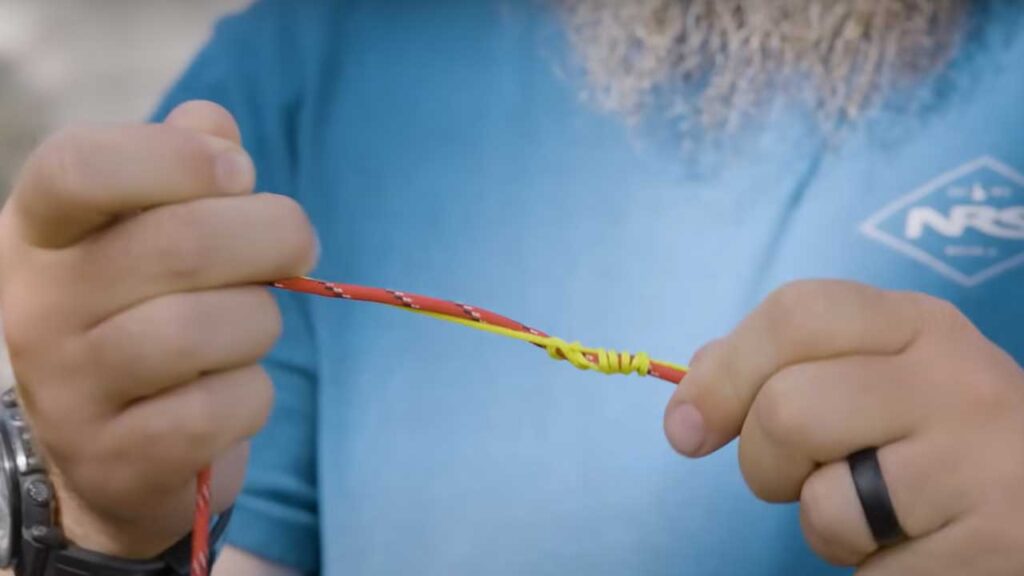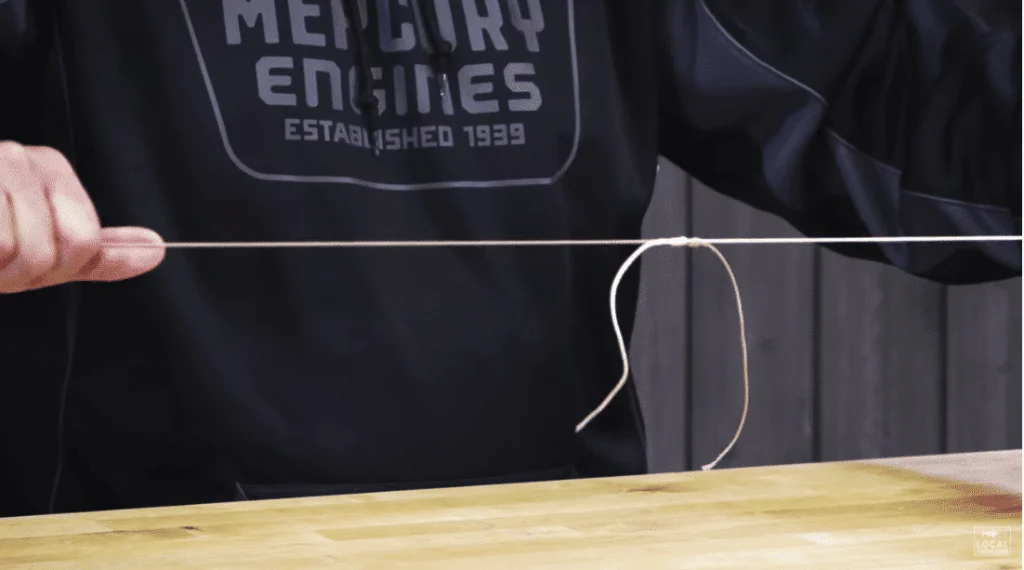Double Uni Knot: Essential Guide for Secure Fishing Connections
The double uni knot, also known as the uni-to-uni knot, is a popular and versatile knot that anglers use to connect two fishing lines.

Often employed for joining lines of different strengths and materials, this knot is revered for its strength and ease of tying.
Whether you are a novice angler or a seasoned pro, mastering the double uni knot can significantly enhance your fishing experience.
To tie a double uni knot, overlapping the ends of the two lines is the first step.
Then, create several wraps with each line while forming loops and tightening them up in sequence.

This method ensures a reliable connection between the lines, capable of withstanding force while increasing the length of your fishing line or connecting different line materials.
Various tutorials, such as this one on NetKnots, provide comprehensive instructions for tying a double uni knot.
In addition to its impressive strength, the double uni knot is lauded for its adaptability across a range of fishing situations.
Whether you are out fishing in freshwater or saltwater, connecting a leader to your mainline, or attaching two lines of varying diameters, this knot holds firm.
Overall, the double uni knot is a must-know knot for any angler, ensuring a secure connection in your fishing setup.
Overview of the Double Uni Knot
The Double Uni Knot is a popular and versatile fishing knot used by both saltwater and freshwater anglers.
This knot is highly effective in joining two lines together, especially when the lines have different strengths or diameters. Known for its reliability and simplicity, the Double Uni Knot retains a high percentage of the line's breaking strain, often around 90%.
This knot is created by overlapping the ends of both fishing lines and tying two individual Uni Knots.
The technique involves making wraps around both lines and then pulling the tag ends to tighten the knots, forming a strong and secure connection.
The key factors to consider when tying a Double Uni Knot include the number of wraps and the tension applied to the lines.

For better knot strength and performance, most anglers recommend using eight turns with braid line and six or more turns for mono/fluoro line.
However, if using heavier mono/fluoro, fewer turns may be more appropriate.
The Double Uni Knot's effectiveness makes it the ideal choice for various fishing situations where joining mono/fluoro to braid is required.
When properly tied, the Double Uni Knot creates a low-profile connection, allowing for smooth casting and reduced friction through the guides.
This knot is suitable for joining leaders to the mainline, attaching terminal tackle, and attaching lures.
To ensure optimal knot strength, it is essential to properly moisten the knot before pulling it tight.
Benefits and Applications
Strength and Durability
The Double Uni Knot is known for its impressive strength and durability. This knot retains up to 90% of the breaking strain of the line used, making it highly reliable in most fishing situations.
Strength is vital when fishing in both freshwater and saltwater environments, as a weaker knot may result in a lost catch.
Moreover, the Double Uni Knot's ability to maintain its knot strength across various fishing lines and scenarios makes it an excellent choice for anglers of all skill levels.
Suitability for Different Fishing Lines
Another advantage of the Double Uni Knot is its compatibility with multiple types of fishing lines, such as mono, fluorocarbon, and braided lines.
It is highly effective in joining mono/fluoro to braid, making it suitable for a wide range of fishing applications.
As a general guideline, use eight turns with the braid line and six or more for the mono/fluoro while tying the knot. This ensures that the knot remains strong and secure during fishing activities, regardless of the line type.
Advantages Over Other Knots
The Double Uni Knot offers several advantages over other knots used in fishing:
- Its versatility allows for easy adaptation to various fishing situations and lines.
- The simplicity of The Double Uni Knot makes it an excellent option for beginners, as the tying process is straightforward and easy to follow. Learn how to tie a Double Uni Knot with these instructions.
- The reliability and strength of the Double Uni Knot make it a popular choice among experienced anglers who demand a secure knot for their fishing activities.
- Its smooth and compact nature reduces the likelihood of snags or tangles, increasing the overall efficiency and effectiveness of your fishing experience.
In comparison with other common fishing knots, the Double Uni Knot stands out due to its ability to maintain strength, versatility, and ease of use. It is an essential knot for both beginner and experienced anglers looking to improve their arsenal of knot-tying options.
Tying the Double Uni Knot
Preparation
Before starting to tie the Double Uni Knot, gather the two lines you want to connect, whether it's connecting a leader to the main line, or joining two different diameter lines.
Make sure you have a sufficient length of the tag ends to create the necessary wraps for a secure connection.
It's also helpful to have a small cloth to moisten the knot when tightening, as wet knots tend to reduce friction and create a more secure connection.
Step-by-Step Instructions
- Overlap the ends: Place the ends of the two lines next to each other, with their ends pointing in opposite directions.
- Form the first loop: With the line from the left, double back and make a loop by crossing the line over itself.
- Create the wraps: Make 3-4 wraps around both lines, passing the tag end through the loop formed in step 2.
- Tighten the first knot: Gently pull on the tag end of the line on the left to tighten the wraps, making sure the wraps are even and snug.
- Form the second loop: Take the tag end of the line from the right, double back and create a loop by crossing the line over itself.
- Create the wraps: Make 3-4 wraps around both lines, passing the tag end through the loop formed in step 5.
- Tighten the second knot: Gently pull on the tag end of the line on the right to tighten the wraps, making sure they are even and snug.
Securing and Testing the Knot
- Moisten the knot: Wet the knot with water or saliva using a small cloth to reduce friction and prevent damage to the lines when tightening.
- Pull the mainlines: Gently pull the mainlines in opposite directions to slide the two knots towards each other, creating a strong connection between the lines.
- Test the knot: Apply pressure to the knot by pulling the connected lines with some force. If the knot holds without slipping, the Double Uni Knot is successfully tied.
Comparing Knots
Double Uni Knot vs FG Knot
The Double Uni Knot is a popular choice among anglers for connecting two lines of different materials or diameters.
The knot is known for its simplicity and strength, making it suitable for various fishing situations.
On the other hand, the FG Knot is gaining popularity for its slim profile and minimal impact on casting distance.
The FG Knot excels in connecting braided line to fluorocarbon or monofilament leaders, with impressive strength and abrasion resistance.
To differentiate further, the Double Uni Knot follows a simple tying process and is easy to learn, even for beginners.
The FG Knot, while slightly more complex, provides a smoother transition between the lines and is less likely to snag on guides. However, it might take some practice to effectively tie the FG Knot.
Double Uni Knot vs Blood Knot
The Blood Knot serves a similar purpose as the Double Uni Knot, as it also connects two lines together.
However, the Blood Knot is generally used to join lines of similar materials and diameters.
While both knots are strong and reliable, the Blood Knot offers a more streamlined profile, which reduces line resistance as it moves through the water or the guides.
That being said, the Double Uni Knot is generally considered easier to tie, especially with lines of different diameters, making it a more versatile option.
In contrast, tying a Blood Knot can be trickier with dissimilar line types and for users with less experience or dexterity.
Other Alternatives
While the Double Uni Knot, FG Knot, and Blood Knot each have their benefits, other alternatives might suit specific angling needs.
For instance, Alberto Knot is another popular option for joining lines of different materials.
This knot is particularly efficient when connecting fluorocarbon or monofilament leaders to braided lines, and it shares some similarity with the FG Knot in terms of low-profile appearance and reduced friction on the guides.
Lastly, the term Uni-to-Uni Knot is often used interchangeably with the Double Uni Knot.
They are technically the same knot, where two individual Uni Knots are used to connect the lines. The term emphasizes the function and strength of this tried-and-true knot in various fishing applications.
Modifications and Variations
Adjustments for Line Type and Diameter
When tying the Double Uni Knot, it is important to consider the type and diameter of the lines being used.
For braided lines, use more turns compared to mono line or fluoro lines. For lighter tackle scenarios, use eight turns for the braided line and six turns or more for the mono/fluoro.
When working with heavier mono/fluoro lines, you might want to decrease the number of turns.
The Double Double Uni Knot
The Double Double Uni Knot is an enhanced version of the Double Uni Knot. This knot provides an even stronger connection between lines, making it suitable for situations when extra strength is required.
To tie the Double Double Uni Knot, follow the same steps as the Double Uni Knot but make additional wraps with each line. Make sure to maintain consistency and balance in the number of wraps to ensure the knot's effectiveness.
Innovations and Special Uses
In recent years, anglers have been making innovations to the Double Uni Knot, tailoring it for specific requirements. One such variation is the use of the knot to connect tapered leaders to the main line or to a swivel.
The Double Uni Knot can be adjusted according to the diameter of the leader and the main line to ensure a secure connection. This versatility makes it a popular choice among anglers for various fishing situations.
Practical Tips for Anglers
Knot Maintenance
Anglers should periodically check their knots, especially after catching a fish or encountering any resistance. This helps ensure that the knot remains strong and minimizes the risk of line damage.
Saltwater anglers, in particular, should frequently inspect their knots due to the corrosive effects of saltwater on the line.
When joining lines with a double uni knot, make sure to use the appropriate number of wraps for each line type. Commonly, five to six wraps are recommended for a fluorocarbon leader, while three to four wraps are suitable for a monofilament leader, as found on netknots.com.
Troubleshooting Common Issues
Below is a table listing common issues that may arise while tying a double uni knot and their recommended solutions.
| Issue | Solution |
|---|---|
| Uneven wraps | Ensure that each wrap is consistent, secure, and evenly spaced |
| Line slipping | Apply more wraps for the line type, increase tension when tightening |
| Knot misalignment | Properly align both uni knots before tightening |
Expert Advice
Well-known bass fishing expert Roland Martin suggests that when tying a double uni knot, you should moisten the lines before tightening. This helps reduce friction and heat generated while tightening, thereby strengthening the knot.
Furthermore, make sure to tightly and evenly wrap the standing lines to ensure the knot's integrity.
Additional Considerations
Environmental Factors
Environmental factors should be taken into account when using the double uni knot. For instance, saltwater fishing may require additional care due to the corrosive nature of saltwater, which can weaken knots over time.
Ensure to properly rinse and maintain your fishing lines and knots when fishing in saltwater environments.
Gear and Tackle Choices
When choosing your gear and tackle for fishing, consider the type of fishing lines you're using. Different materials, like monofilament, fluorocarbon, or braided lines, may require adjustments when tying the double uni knot.
For instance, it is recommended to use more turns with braided lines than with monofilament or fluorocarbon lines as they can be more prone to slipping.
Here's a reference table for the number of turns:
| Line Type | Recommended Turns |
|---|---|
| Braided Line | 8 turns |
| Monofilament | 6 turns |
| Fluorocarbon | 6 turns |
Fishing Scenarios and Strategy
Depending on the fishing scenario and the species of gamefish targeted, the use of double uni knots may face different challenges.
Factors such as breaking strength, diameters of the lines, and how well the knot cinches and slides together can affect its overall performance.
To tie a double uni knot efficiently, overlap the two lines, making sure to leave enough tag ends for tightening.
Maintain a low profile for the knot by trimming any excess tag ends, and make sure the knot slides together smoothly.
Tightening the knot is often considered a challenge, but with practice, one can master this skill and tie knots quickly and effectively.
Frequently Asked Questions
How do I tie a double uni knot when connecting braid to fluorocarbon?
To tie a double uni knot when connecting braid to fluorocarbon, overlap the ends of the braided line and fluorocarbon line.
With the braided line, make 3 to 4 wraps around both lines and through the loop formed, then pull the tag end to tighten.
Repeat the process with the fluorocarbon line, this time making 5 to 6 wraps for optimum knot strength Double Uni Knot Like a Pro.
What are the advantages of using a double uni knot for braid to mono?
Using a double uni knot for connecting braid to mono offers several advantages.
The knot is not only strong and reliable, but also relatively simple to tie. Additionally, the double uni knot works well with lines of differing diameters and materials, making it versatile for various fishing scenarios.
How does the strength of a double uni knot compare to that of a blood knot?
The double uni knot is considered one of the strongest knots for connecting two lines, while the blood knot is also praised for its strength and dependability.
However, the double uni knot has an edge when it comes to connecting lines of different materials and diameters, which makes it a more versatile option.
What modifications can be made to improve the standard double uni knot?
One modification to improve the standard double uni knot is doubling the line before tying each uni knot in the process Double Uni (Uni-to-Uni Knot).
This can increase the knot's strength and reduce the likelihood of slippage. Keep in mind that additional wraps may be necessary when dealing with thinner lines or when using braided line.
Can the double uni knot be effectively used to connect two braided lines?
Yes, the double uni knot can be effectively used to connect two braided lines.
Just make sure to use the same or similar number of wraps for each line, and test the knot carefully for strength and security before relying on it in a fishing scenario.
In what scenarios should I choose a double uni knot over an FG knot?
Choose a double uni knot over an FG knot when you need a versatile and strong knot to connect lines of different materials or diameters.
The FG knot is known for its ultra-low profile and strength when connecting braid to fluorocarbon or mono. However, it can be more complicated to tie and may not be as versatile as the double uni knot for various fishing situations.
Charlie is Editor-in-Chief of Sea Magazine







